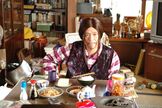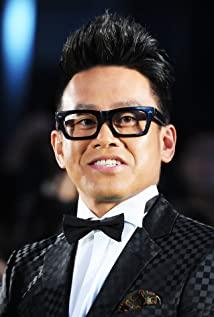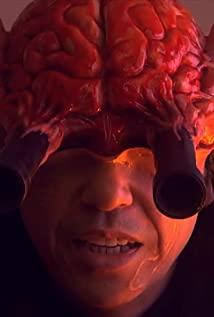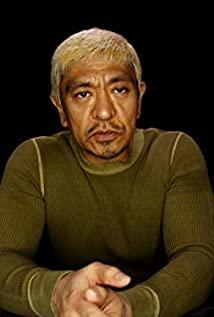"The Great Japanese": absurd and realistic essay in the abstract sense . Vulcan Ji.
Greater; but only a body. Hidden in that huge body; is a timid, weak, incompetent middle-aged man.
This is a tragic and solemn reality of Japan's beat generation; despite the so-called national prejudice, this movie is still worth watching. - Vulcan Ji. Inscription.
In my opinion, this is a realistic film; it's just that it is different from the realism in the form of general records, but uses an abstract technique and absurd imagination for realism. Some people say that in this film, you can see all kinds of real problems in modern Japanese society; such as social aging, middle-aged unemployment, divorce, abandoned babies, dependence on the United States and so on. I thought, maybe overthinking it. Realism may not necessarily be a social problem; what I see in this film is a sense of loss with a strong sense of despair, as well as a confused sadness.
Before watching this movie; the four big characters of "Big Japanese" can easily make people resist. After watching this movie; a fearless and brave grandfather, a father who likes to do things but died young, seems destined to be a fearful and timid son.
When encountering an enemy stronger than himself, he turned around and ran away; he killed a baby by mistake, but dared not take responsibility for the masses; he even killed his grandfather who was protecting him while escaping; in the end, he had to hide under the protection of Uncle Sam. . This is a portrayal of the life of a generation of down-and-out Japanese, with a little bit of symbolism and a bit of absurd ridicule. Titled "The Great Japanese"; to make this sarcasm even stronger.
The film is in the form of a documentary; a combination of video interviews and some beautifully crafted CGI footage. At first I thought it was a documentary, and I thought "big Japanese" was a profession in some kind of Japanese folklore; exorcists, for example. However, the interviewee in the documentary interview program suddenly entered the substation and turned into a giant after turning it on, which is a bit surreal.
The solid documentary interview program made me question my judgment; so the film suddenly became a documentary with beautifully crafted CGI to show the exorcism scene in the folklore tradition. I didn't realize until the end of the movie that I had been fooled by Matsumoto Chi for two hours. This is a rather different viewing experience; the movie is still a movie, and the scene where the heroic profession that thousands of people have been looking forward to has now fallen is not real, it is just a basic plot setting in the movie, and all assumptions are based on this basic concept above.
From documentaries to interview movies + CGI scene assumptions to the final thorough assumptions. In those two hours, the film made three jumps.
When I saw Hideo Yamamoto's name, I wasn't at all surprised by what I saw. In my memory, Hideo Yamamoto is always linked with Takashi Miike; like Wong Kar-wai and Du Kefeng. Perhaps because of my fascination with Takashi Miike's films, watching those scenes in this film always feels familiar. If you've seen Takashi Miike's "Monster War" and come back to watch this movie, maybe you'll understand what I'm talking about.
It's the same as a shot, backlit lens. The dazzling sunlight and the shivering middle-aged man walking with his head down; I wonder what our middle-aged age will look like. Then, we are middle-aged. It's a scary fantasy.
A hypothetical occupation. A middle-aged man who is always running around to protect his motherland and defeating all monsters; but, because people no longer believe in monster legends, so even though he has great strength and brave determination, he still lives in poverty. It took less than two generations for this country to go from degenerate hero to near-unemployed middle-aged man.
Let's take a look at the kind of life that this supposedly heroic man lived: a desolate courtyard, a messy room, long tousled hair, walls covered with portraits of heroes' ancestors, separated awaiting divorce, every six months. Seeing a daughter once, going to various cities to fight scary legends about monster attacks, eating instant food and udon noodles, riding a tram or driving a battered motorcycle...
If we say; this figure represents the image symbols of traditional Japanese culture. Well, this movie is clearly more than the simple hypotheses it says; it becomes a realistic history of the degeneration of traditional Japanese culture. What it shows us is the decline of traditional culture, the impetuousness of modern young people, and the misinterpretation and invasion of oriental culture by western culture. At this point, the film may reflect more than just Japan's social issues and cultural trends; most Asian countries are also facing the same embarrassing situation.
At the end of the movie, the big Japanese was defeated by a powerful western devil and fled, and when he fled in panic, he killed his grandfather who dared to challenge the enemy, the fourth generation of the big Japanese. In the end, he could only take shelter in the American superman Jas. The Tes family survived, obediently obeying all their orders. When the movie reaches this point, the world-like taste it shows is even stronger.
Throw away your shoes; Uncle Sam will fly with you. However, it wasn't just a pair of shoes that fell to the ground as a Japanese superman, Sato Daisho; what he lost was the most basic dignity as a nation and the trust of those kind people in him. It's just that he has no choice, he can only compromise with those American supermen who shelter him with more power than him. Sitting at the same table to eat, all the people can shout; except this Japanese Superman, who can only whisper and can't resist the "must" order from the American Superman parent.
Perhaps, throw away the tradition; we really have nothing left. This film uses an abstract and absurd approach to depict the embarrassing situation of Japanese modern culture, satirizes the current situation of Japan that blindly worships foreigners, and ruthlessly stabs those weak, incompetent, timid and helpless modern youths. The Great Sadness of Sato is actually the sadness of Japan, and it is also the sadness of most Asian countries now.
Nearly unemployed middle-aged man. Live alone. Raised wild cats. Dreaming of a false hero. Telling grandiose lies. Runs to get drunk and refuses to take responsibility when the baby is killed by the wrong hand. Turn around and run away when you encounter a strong enemy. Tribute to the heroic ancestors on the wall. But he hides in a powerful body with a humble and weak character. Accepting everything Uncle Sam gave him. "The Great Japanese" depicts the era of a broken little Japan.
The last thing I want to say is that the song in the episode of this movie and the middle-aged man who stumbles alone in the rain after getting drunk are probably the most emotional scenes in the movie. Very poignant; very sad; very lonely; very helpless.
2008/01/27; Bingyin day, Gui Chou month, Dinghai year. May 9th day 1.
P.S.: Movie information extension link.
■Title: Big Japanese
■Translation: Big Man Japan
■Director: Hitoshi Matsumoto
■Screenwriter: Hitoshi Matsumoto/Mitsuyoshi Takasu
■Actor: Hitoshi Matsumoto Matsumoto/Itsuji Itao/Ryunosuke Kamiki/Riki Takeuchi/Ua/Haruka Unabara
Photography: Hideo Yamamoto
Country: Japan
■Language: Japanese
■Genre: Comedy
■Duration: 113 minutes
■Distribution: Shochiku Movie
■Released: June 2, 2007 (Japan)
http://cyacz.blog.163.com/blog/static/9826992008153050761/
View more about Big Man Japan reviews











